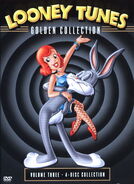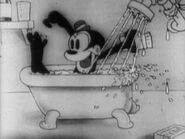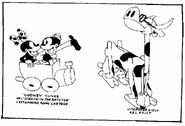Sinkin' in the Bathtub is a 1930 Looney Tunes short directed by Hugh Harman and Rudolf Ising.
Title[]
The title is a play on the very song featured in the film, "Singing in the Bathtub."
Plot[]
Bosko is happily washing himself and whistling "Singing in the Bathtub" in the bathtub, turning random objects into instruments, like a shower spray into a harp. Even his bathtub starts to dance! A nude Bosko pulls his pants up by pulling on his hair. He changes the direction of the shower spray to whisk him outside. Suddenly, he pulls a huge harmonica out of his pants and plays a tune while dancing toward his garage. His automobile, however, comes out of an outhouse and walks over to Bosko. Bosko cranks the starter and begins his ride, playing his harmonica and scat-singing "Tip Toe Through the Tulips" while picking up tulips in a field. He stuffs the tulips in his car horn as he stops at his girlfriend, Honey's house where she is also singing in the bathtub.
She notices Bosko, gets dressed and greets Bosko from her small balcony on her top floor. As he is about to surprise Honey with the tulips, a random goat eats them. Realizing this problem, he starts to cry but Honey reassures to Bosko that she still loves him. The goat then blows a raspberry which leads to Bosko kicking the goat's rump over his head. Bosko then makes a saxophone out of two pieces of his car. He then plays a tune much to Honey's dismay. She gets so annoyed that she pours bubble formula into his saxophone. Bubbles blowing out of the sax, he then plays, "I'm Forever Blowing Bubbles". Honey dances on the bubbles in a rhythmic pattern before traveling down to greet Bosko. Bosko then dances on the wooden board walkway which makes an xylophone tone. He then advises Honey to enter the automobile. They drive happily until a cow, chewing cud, blocks the road. The cow ignores Bosko and spits on the front of his automobile, flattening it.
Bosko pulls the front back up and pushes the cow's body below its legs for an easy way to get across. The cow, astonished, winds up its tail to get his head to normal height and walks away. The couple laughing do not notice a big rock which launches Bosko out of the automobile and into eight mini-Boskos who regroup to one. Bosko then chases the automobile up a hill and catches up with the runaway car. The car pops but goes back to normal. Bosko then pushes the car lightly up the hill, but downhill, is another story.
Honey screams, "Help!" repeatedly as the car slides downhill. Bosko, out of the car, catches up and pulls on the (flexible) exhaust pipe. The pipe drags Bosko through an array of boulders and trees and yes, boulders again. Bosko then lands in front of the car. Bosko then yells, "Mammy!!!" (which is usually muted in modern showings). After the automobile goes through the doors of the house, undamaged. The car launches off a cliff and lands on a spiral-shaped road way (like a corkscrew). Honey falls out of the car but lands back in several times. They come across a cliff. Bosko, realizing it's a dead-end, jumps off with Honey and car behind. Bosko's pants are snagged on a tree branch above a pond, and Honey and her car fall into the pond. The resulting wave turns into a hand, frees Bosko from the tree, and places him into the car. Happy, Bosko uses reeds to hit on lily-pads like a xylophone for one more performance of "Singing in the Bathtub".
Music Cues[]

- Michael H. Cleary, Herb Magidson, and Ned Washington - "Singin' in the Bathtub" - plays throughout the short.
- Felix Mendelssohn - Frühlingslied ("Spring Song") - plays when the bathtub dances with a towel.
- Joseph M. Daly - "Chicken Reel" - played by Bosko with a harmonica.
- "Shave and a Haircut" - played by Bosko at the end of his performance.
- Al Dubin and Joe Burke - "Tiptoe Through the Tulips" - plays when Bosko starts riding his automobile, when he makes a saxophone, and when he dances on the wooden board.
- Ray Perkins - "Lady Luck" - plays when the goat eats Bosko's flowers.
- Theodore Moses-Tobani and Mary D. Brine - "Hearts and Flowers" - plays when Bosko starts crying.
- Al Dubin and Joe Burke - "Painting the Clouds with Sunshine" - plays when Honey consoles Bosko and when both of them laugh at a cow.
- John William Kellette and Jaan Kenbrovin - "I'm Forever Blowing Bubbles" - plays when bubbles start blowing out of the saxophone.
- Harry Birch and William Gooch - "Reuben and Rachel" - plays when a cow blocks the road.
- Sir Edward Elgar - Pomp and Circumstance Marches, Op. 39 - plays when the cow walks away.
Availability[]
Looney Tunes Golden Collection: Volume 3, Disc Two
Looney Tunes Platinum Collection: Volume 2, Disc Three
Censorship[]
- Nickelodeon airings of this cartoon removed Bosko yelling "Mammy!" as the car chases him.[3]
Goofs[]
- When the car that Bosko and Honey are riding in trips over a rock about five minutes into the cartoon, Honey's gloves inexplicably disappear. She remains bare-handed for the rest of the short until the ending scene, where she is wearing them again when the car falls into a pond.
Notes[]
- This is the first short in the Looney Tunes series.
- This is the first appearance of Honey, who is Bosko's girlfriend.
- This is Bosko's first appearance in a theatrical film and his second appearance of any kind. His first appearance was in a demo reel called "Bosko the Talk-Ink Kid" (1929), never released commercially, which was created by Harman and Ising to show to Warner Brothers. Bosko became their first star character, surpassed only much later by Porky Pig, Daffy Duck, and Bugs Bunny.
- This is the first publicly released non-Disney cartoon to have a pre-recorded soundtrack (in addition, "Bosko the Talk-Ink-Kid" had a pre-synched track).
- This is the only publicly released Bosko short to feature Bosko's original blackface dialect; he would later adopt a more falsetto voice for later films.
- This is the first cartoon to be scored by Frank Marsales.
- Theatrically released in the USA with The Song of the Flame (1930).[4]
- For a while, it has been rumored that this cartoon had an animated opening sequence, judging by the static title plaster and the sound effects. Recent scans have confirmed this to be false.
- The scenes in which Bosko's mouth fills the screen and he splits into miniature versions of himself were previously done in "Bright Lights" (1928), an Oswald the Rabbit cartoon that Hugh Harman and Rudolf Ising worked on while they were at Disney.
- This short was erroneously copyrighted under the title "Singin' in the Bathtub" on 11 June 1930.[5]
- The climatic scene where Bosko is being chased by his own car down the hill is animated with the background moving in perspective.
- The animation of the cow blocking the road, chewing, and spitting tobacco at Bosko's car was later reused in "Smile, Darn Ya, Smile!"
- The plot of the cartoon is very nearly identical to a post-Disney Oswald the Lucky Rabbit cartoon known as Sick Cylinders.
- Incidentally, Hugh Harman worked on Sick Cylinders.
- The song "Singin' in the Bathtub", sung here by Bosko, was originally introduced in the 1929 Warner Bros. feature The Show of Shows. In addition to everything else, "Singin' in the Bathtub" was Warner Bros.'s response to MGM's "Singin' in the Rain", which was named after the song written in 1929, years before the Gene Kelly movie.
- This cartoon lapsed into the public domain in 1958 due to its most recent copyright holder, Guild Films, not renewing the copyright in time.
Gallery[]
References[]
- ↑ Barrier, Michael (1999). "Disney's Rivals, 1928-1937", Hollywood Cartoons: American Animation in Its Golden Age. Oxford University Press, page 158. ISBN 978-0195167290.
- ↑ https://rateyourmusic.com/film/sinkin_in_the_bathtub/
- ↑ https://web.archive.org/web/20051212002921/http://looney.goldenagecartoons.com/ltcuts/ltcutss.html
- ↑ http://looneytunes.popgeeks.com/1930-year/sinkin-in-the-bathtub/
- ↑ Copyright Office, Library of Congress (1929). Catalogue of Title Entries of Books and Other Articles Entered in the Office of the Register of Copyrights, Library of Congress, at Washington, D.C.. U.S. Government Printing Office.











